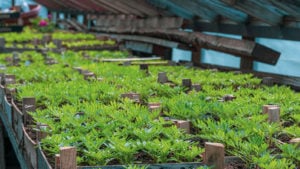Here’s something that caught my attention. InvestorPlace contributor Luke Lango posited that Appharvest (NASDAQ:APPH) stock could actually be the best stock pick of the decade.

Source: Silga Bauge-Robezniece / Shutterstock.com
Lango doesn’t typically say things like that, so I had to delve deeper into APPH stock.
Shockingly, there’s a serious food problem in the world, to the point where there might not be enough food to feed people by 2050.
To grow, food needs enough water and land, as well as the right temperatures. The conditions have to be just right, and the solution may be high-tech indoor farming greenhouses.
This could represent a giant leap forward in addressing the planet’s food problems – and a ground-floor opportunity for investors.
A Closer Look at APPH Stock
APPH stock began trading on the Nasdaq Exchange on Feb. 1. The share price was close to $36 at that time.
AppHarvest received approximately $475 million in gross proceeds as a result of the initial public offering (IPO). Jonathan Webb, the founder and CEO of AppHarvest, seemed quite optimistic during the IPO.
“Today marks an important milestone for AppHarvest and for American agriculture as we drive the next chapter of our growth as a public company,” Webb said.
Unfortunately, the trading community wasn’t necessarily as optimistic as AppHarvest’s founder.
Almost immediately after the IPO, APPH stock plunged. By May 13, the stock had fallen to $13 and change.
In early July, the share price was approaching $15, so the worst might be over for AppHarvest’s investors.
Does the post-IPO slide mean that AppHarvest is actually a bad company to invest in?
If anything, the evidence points to a bright future, even if the market hasn’t recognized this yet.
Well, maybe I shouldn’t say that. APPH stock recently joined the Russell 2000 index, so that counts as recognition, I suppose.
The Next Big Industry
“Forget EVs. Forget AI. Forget self-driving cars,” Lango said. Ag-tech (agricultural technology) start-ups like Square Roots, Plenty and AeroFarms represent the next big industry.
Those small businesses, along with AppHarvest, are creating indoor farming facilities in the U.S. – and therefore are helping to prevent a food shortage crisis before it’s too late.
And, AppHarvest is publicly tradable right now. This creates an easy way to invest in what could be the future of modern agriculture.
Besides, APPH stockholders are investing in a niche leader. AppHarvest runs one of the world’s largest indoor farming operations.
We’re talking about a greenhouse the size of 58 football fields. Go big or go home, right?
AppHarvest’s operations are located in Appalachia, just outside of Morehead, Ky.
The company’s founder is a real character, almost like the Elon Musk of ag-tech.
“Everybody watch out for Central Appalachia. We are absolutely going to be one of the largest fruit and vegetable suppliers in the U.S. in the decades to come,” Webb unabashedly boasted.
Agriculture With a Modern Angle
Farming is an ancient science, but in order to feed the world, businesses will need to leverage the best that modern technology has to offer.
That’s precisely what Webb and his company are aiming to achieve.
For example, tomatoes can grow year-round and all night long in AppHarvest’s greenhouse.
That’s due to special grow lights, which keep the plants inside developing – all 720,000 of them.
Moreover, AppHarvest reportedly asserts that farming with this method uses 90% less water and no soil.
Plus, it results in 30 times more yield per acre than a traditional outdoor farm.
A significantly greater output, with a reduced environmental impact. Now, that sounds like innovation to me.
The Bottom Line
While I’m not quite prepared to forget about self-driving cars, I definitely see Lango’s point here.
AppHarvest is a tradable company that’s emerging as an early niche leader.
And, the company offers an irresistible proposition: leveraging modern technology to help feed the world, while providing incredible value to investors.
On the date of publication, David Moadel did not have (either directly or indirectly) any positions in the securities mentioned in this article. The opinions expressed in this article are those of the writer, subject to the InvestorPlace.com Publishing Guidelines.





More Stories
U.S. charges FTX founder Sam Bankman-Fried with criminal fraud
Time series forecasting with XGBoost and InfluxDB
Full-stack engineering is one-third as good